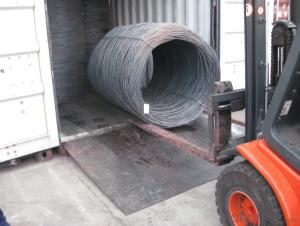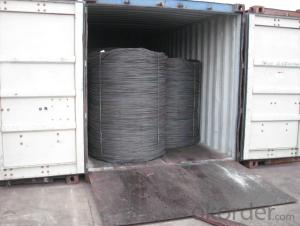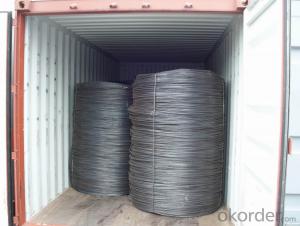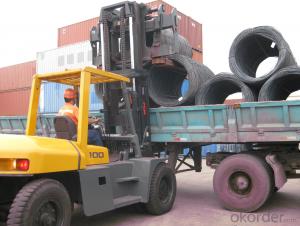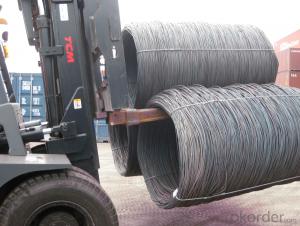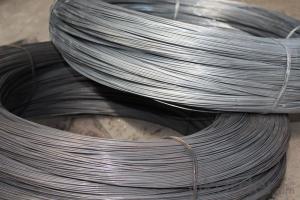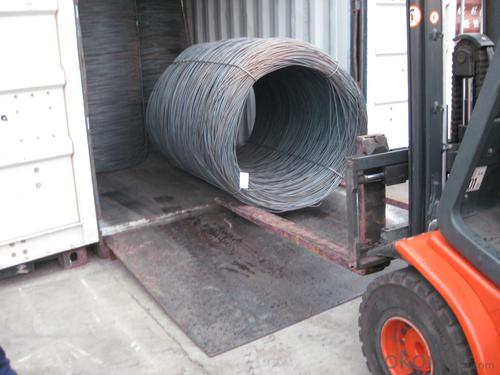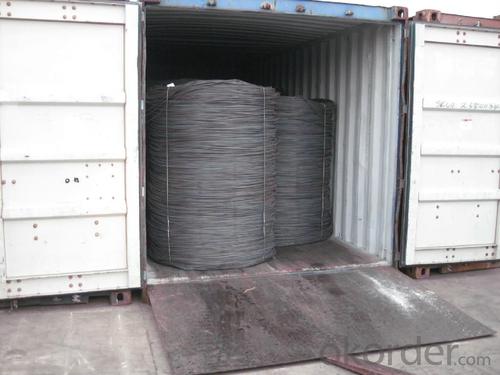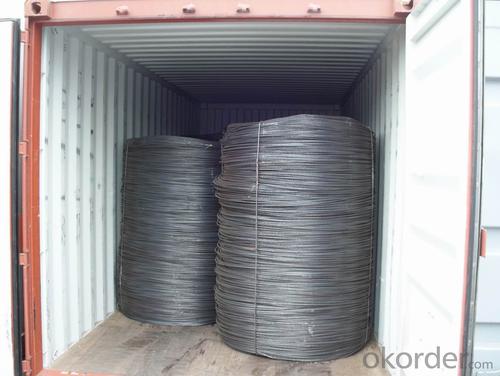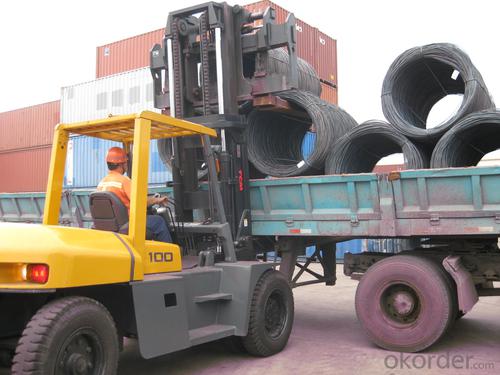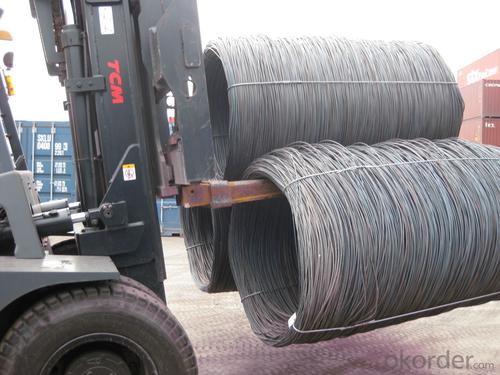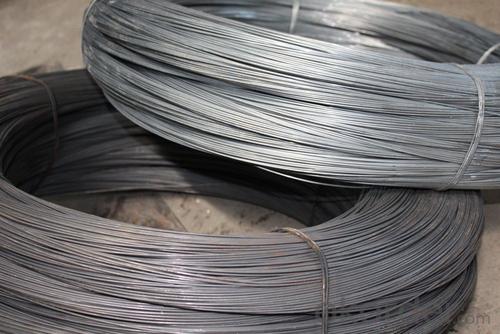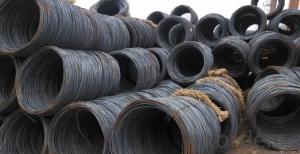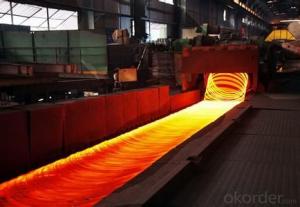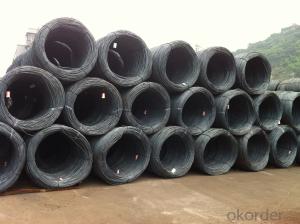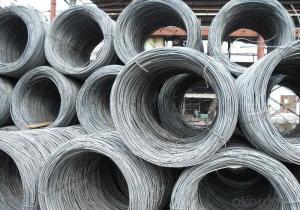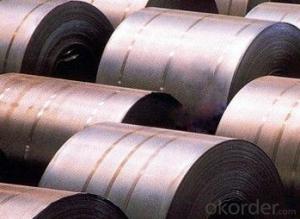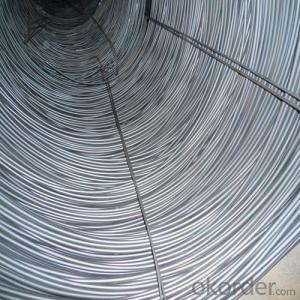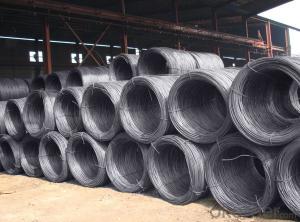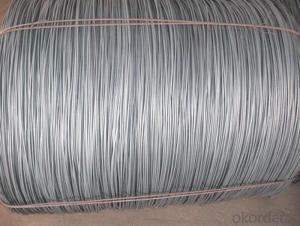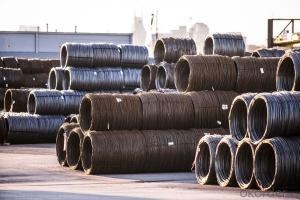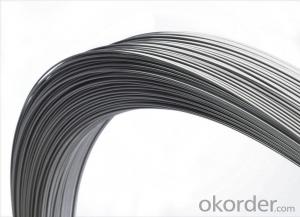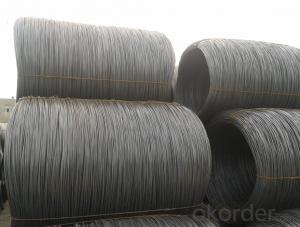SAE1006Cr Carbon Steel Wire Rod 11mm for Welding
- Loading Port:
- Shanghai
- Payment Terms:
- TT OR LC
- Min Order Qty:
- 100 m.t
- Supply Capability:
- 30000 m.t/month
OKorder Service Pledge
OKorder Financial Service
You Might Also Like
Specification
Description of SAE1006Cr Carbon Steel Wire Rod 11mm for Welding:
OKorder is offering Color Coated Steel Coil Prepainted Steel Coil at great prices with worldwide shipping. Our supplier is a world-class manufacturer of steel, with our products utilized the world over. OKorder annually supplies products to European, North American and Asian markets. We provide quotations within 24 hours of receiving an inquiry and guarantee competitive prices.
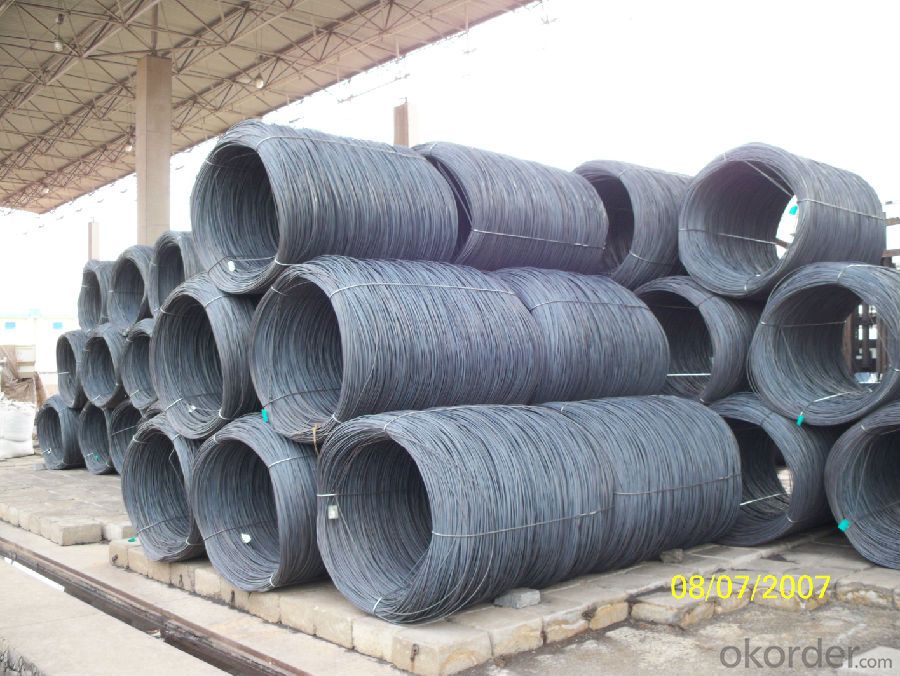
Applications of SAE1006Cr Carbon Steel Wire Rod 11mm for Welding:
Color Coated Steel Coil Prepainted Steel Coil are ideal for structural applications and are widely used in the construction of buildings and bridges, and the manufacturing, petrochemical, and transportation industries.
Main Product Features of SAE1006Cr Carbon Steel Wire Rod 11mm for Welding:
· Premium quality
· Prompt delivery & seaworthy packing (30 days after receiving deposit)
· Corrosion resistance
· Can be recycled and reused
· Mill test certification
· Professional Service
· Competitive pricing
Specifications of SAE1006Cr Carbon Steel Wire Rod 11mm for Welding:
PPGI:
1, Introduction: Color coated steel coils(sheets), i. E. PPGI, also called prepainted steel coils(sheets), are made of galvanized steel coils(sheets) with polymer coatings as surface. It's a new enclosure material and building board with characteristics of light-weighted, heat preserved&insulated, easily installed with bright colors.
2, Production Process: Pretreatment(Degreasing)_Drying_Chromating_Paint Basic Oil_Cooling_Drying_Color Coating_Cooling_Film-covering_Rolling Up
3, Characteristics:
Good at corrosion resistence. Besides zinc coating of the basic plate of galvanized steel sheet, the color coating as the surface has double lifetime to ensure better anticorrosion effect.
With excellent cold bending molded manufacturablity, PPGI products can be processed or directly used as final product. As being light-weighted and conveniently transported, they're widly used to replace wood to save energy.
4.There're thousands of colors can be chosen as per different application. Any color plays well in decoration.
No pollution with high recycling rate, PPGI coils and sheets are strongly recommended as enviroment-friendly products by the government.
5, eye bands and 4 circumferential bands in steel, galvanized metal fluted rings on inner and outer edges, galvanized.
| commodity | SAE1006Cr Carbon Steel Wire Rod 11mm for Welding |
| Techinical Standard: | JIS G3302-1998, EN10142/10137, ASTM A755 |
| grade | Q195,Q215,Q235,SAE1006,SAE1008 SAE1006Cr |
| Types: | Mesh welding |
| Base metal | galvanized, galvalume, cold rolled steel |
| Thickness | 0.14-1.0mm(0.16-0.8mm is the most advantage thickness) |
| Width | 610/724/820/914/1000/1200/1219/1220/1250mm |
| Type of coating: | PE, SMP, PVDF |
| Zinc coating | Z60-150g/m2 or AZ40-100g/m2 |
| Top painting: | 5 mic. Primer + 15 mc. R. M. P. |
| Back painting: | 5-7 mic. EP |
| Color: | According to RAL standard |
| ID coil | 508mm610mm |
| Coil weight: | 2--3MT |
| Package: | Properly packed for ocean freight exportation in 20'containers |
| Application: | Industrial panels, roofing and siding for painting/automobile |
| Price terms | FOB, CFR, CIF |
| Payment terms | 20%TT in advance+80% TT or irrevocable 80%L/C at sight |
| delivery time | 25 days after recepit of 20% TT |
| Remarks | Insurance is all risks |
| MTC 3.1 will be handed on with shipping documents | |
| We accept SGS certificatation test |
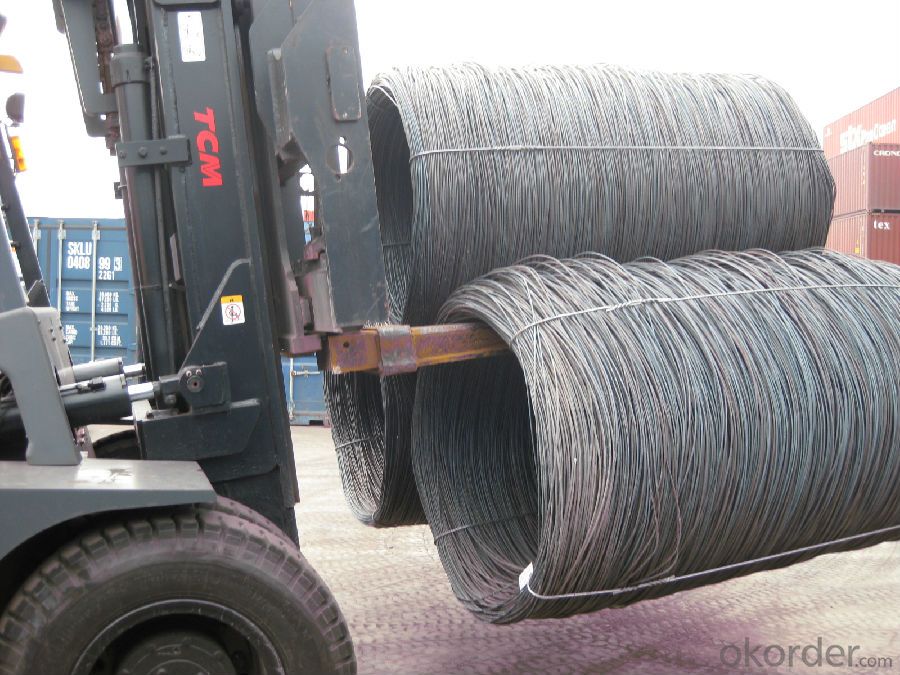
FAQ of SAE1006Cr Carbon Steel Wire Rod 11mm for Welding:
Q1: Why buy Materials & Equipment from OKorder.com?
A1: All products offered byOKorder.com are carefully selected from China's most reliable manufacturing enterprises. Through its ISO certifications, OKorder.com adheres to the highest standards and a commitment to supply chain safety and customer satisfaction.
Q2: How do we guarantee the quality of our products?
A2: We have established an advanced quality management system which conducts strict quality tests at every step, from raw materials to the final product. At the same time, we provide extensive follow-up service assurances as required.
Q3: How soon can we receive the product after purchase?
A3: Within three days of placing an order, we will begin production. The specific shipping date is dependent upon international and government factors, but is typically 7 to 10 workdays.
Q4: What makes stainless steel stainless?
A4: Stainless steel must contain at least 10.5 % chromium. It is this element that reacts with the oxygen in the air to form a complex chrome-oxide surface layer that is invisible but strong enough to prevent further oxygen from "staining" (rusting) the surface. Higher levels of chromium and the addition of other alloying elements such as nickel and molybdenum enhance this surface layer and improve the corrosion resistance of the stainless material.
Q5: Can stainless steel rust?
A5: Stainless does not "rust" as you think of regular steel rusting with a red oxide on the surface that flakes off. If you see red rust it is probably due to some iron particles that have contaminated the surface of the stainless steel and it is these iron particles that are rusting. Look at the source of the rusting and see if you can remove it from the surface.
- Q: How is steel wire rod used in the manufacturing of wire forms for lighting fixtures?
- Wire forms for lighting fixtures rely on steel wire rod as a crucial component in their production. This wire rod serves as the primary raw material for crafting various wire forms, such as hooks, frames, and brackets, which are integral to the structure and functionality of lighting fixtures. The manufacturing process of steel wire rod begins with a series of steps. Initially, the wire rod undergoes wire drawing, wherein it is drawn through a series of dies to decrease its diameter and increase its length. This process results in a wire that is smooth, uniform, and of the desired thickness. After the wire has been drawn, it undergoes further processing to create the specific wire forms needed for lighting fixtures. This involves bending, shaping, and cutting the wire to the desired dimensions. To achieve the desired shapes and sizes, various tools and equipment, such as wire forming machines and presses, are utilized. The wire forms crafted from the steel wire rod are then integrated into the production of lighting fixtures. For example, hooks made from these wire forms are used to suspend the fixtures from the ceiling or wall mountings. Frames created from the wire forms provide structural support and hold the components of the lighting fixture in place. Brackets made from the wire forms are employed to attach the fixture to the wall or ceiling. Furthermore, the wire forms made from steel wire rod often serve as decorative elements in lighting fixtures. These wire forms can be shaped into intricate designs and patterns that enhance the aesthetics of the fixture. Various curves, loops, and spirals can be formed to create visually appealing and unique lighting designs. In conclusion, steel wire rod plays a vital role in the manufacturing process of wire forms for lighting fixtures. It offers the necessary strength, durability, and versatility required to create functional and visually appealing lighting fixtures.
- Q: How is steel wire rod used in the manufacturing of wire for fishing lines?
- Steel wire rod is an essential component in the manufacturing of wire for fishing lines as it provides the necessary strength and durability required for fishing activities. It is first drawn through a series of dies to reduce its diameter to the desired thickness, and then coated with a protective layer to prevent corrosion. The resulting wire is then further processed and twisted to create fishing lines of various strengths and lengths, ensuring reliable performance and resilience while fishing.
- Q: How does the fatigue strength of steel wire rod vary with different wire drawing processes?
- The fatigue strength of steel wire rod can vary depending on the specific wire drawing process used. Wire drawing is a metalworking process that involves pulling a metal wire through a die to reduce its diameter and increase its length. There are various wire drawing processes, such as wet drawing, dry drawing, and intermediate drawing, each with unique characteristics and effects on the fatigue strength of the steel wire rod. One factor that affects the fatigue strength is the lubrication used during the wire drawing process. Wet drawing involves immersing the wire rod in a lubricant to reduce friction and heat generation. This lubrication helps in reducing the chances of surface defects and improves the fatigue strength of the wire rod. On the other hand, dry drawing does not involve any lubrication, which can result in increased friction and heat generation, potentially leading to a decrease in fatigue strength. The reduction ratio, which is the ratio of the initial wire diameter to the final wire diameter, also plays a crucial role. Higher reduction ratios can lead to an increase in the fatigue strength of the wire rod as the process aligns the grain structure and improves the overall mechanical properties. However, excessively high reduction ratios can introduce internal defects or residual stresses, which can negatively impact the fatigue strength. The heat treatment process after wire drawing can significantly influence the fatigue strength as well. Heat treatment techniques, such as annealing or quenching, can enhance the microstructure of the wire rod and improve its fatigue strength. Annealing helps in relieving internal stresses and refining the grain structure, while quenching provides increased hardness and strength. These heat treatment processes can compensate for any potential reduction in fatigue strength caused by the wire drawing process. In summary, the fatigue strength of steel wire rod can vary with different wire drawing processes. Factors such as lubrication, reduction ratio, and heat treatment techniques can all influence the fatigue strength. It is essential to carefully select the appropriate wire drawing process and associated parameters to optimize the fatigue strength of the steel wire rod for specific applications.
- Q: How is steel wire rod used in the manufacturing of jewelry?
- Steel wire rod is commonly used in the manufacturing of jewelry as it provides strength and durability to delicate pieces. It is often used as a base material for creating intricate designs, such as wire wrapping or beading, serving as a foundation that holds gemstones, beads, or other decorative elements securely in place. Additionally, steel wire rod can be shaped, bent, and twisted to create unique jewelry components like clasps, jump rings, or chains, offering versatility and creative possibilities for jewelry designers.
- Q: How is the demand for steel wire rod expected to change in the future?
- The demand for steel wire rod is expected to increase in the future due to its diverse applications in various industries such as construction, automotive, and manufacturing. As these industries continue to grow and develop, the need for steel wire rod for products such as cables, wires, and reinforcement materials will also rise. Additionally, advancements in technology and infrastructure projects worldwide will further contribute to the increasing demand for steel wire rod.
- Q: How are steel wire rods used in the manufacturing of tire belts for vehicles?
- Steel wire rods are an essential component in the manufacturing of tire belts for vehicles. These rods are typically made from high-quality steel and play a crucial role in reinforcing the strength and durability of the tire belts. To begin with, steel wire rods are used to form the skeleton structure of the tire belts. They are shaped into a specific pattern, such as a crisscross or spiral, and embedded within the rubber material during the manufacturing process. This reinforcement provides strength and stability to the tire belt, allowing it to withstand the immense pressure and stress that occurs during vehicle operation. Moreover, the steel wire rods enhance the overall performance and safety of the tire belts. They help to maintain the shape and integrity of the belts, preventing them from deforming or collapsing under heavy loads. This is particularly important in ensuring proper traction, stability, and control of the vehicle, especially during cornering, braking, and acceleration. In addition, the steel wire rods also contribute to the tire belts' resistance against punctures and impact damage. The strong and flexible nature of steel allows the rods to absorb and distribute external forces, reducing the risk of tire failure due to road hazards or sudden impacts. This feature is vital for enhancing the longevity and reliability of the tires, ultimately ensuring a safer driving experience. Overall, steel wire rods are an integral part of the manufacturing process for tire belts in vehicles. They provide reinforcement, strength, and durability to the belts, improving their performance, safety, and resistance to various road conditions and external forces.
- Q: How is steel wire rod used in the manufacturing of wire rope assemblies for lifting?
- Steel wire rod is a crucial component in the manufacturing of wire rope assemblies for lifting as it serves as the raw material for creating the individual wires that make up the rope. The steel wire rod undergoes a series of processes, such as drawing, stranding, and closing, to transform it into a strong and durable wire rope. These wire ropes are then used in various lifting applications, such as cranes, elevators, and suspension bridges, providing the necessary strength and flexibility to safely lift and move heavy loads.
- Q: How is steel wire rod used in the manufacturing of wire for bicycle spokes?
- Steel wire rod is used in the manufacturing of wire for bicycle spokes by serving as the raw material. The steel wire rod is first drawn through a series of dies to reduce its diameter and increase its length, resulting in a thinner and longer wire. This wire is then further processed and shaped into the specific gauge and shape required for bicycle spokes. The strength and durability of the steel wire rod make it an ideal choice for bicycle spokes, providing the necessary support and stability to withstand the stress and strain during cycling.
- Q: What are the common industry competencies for steel wire rod professionals?
- Some common industry competencies for steel wire rod professionals include knowledge of steel production processes, understanding of quality control and testing procedures, proficiency in operating and maintaining machinery and equipment, familiarity with industry safety regulations, ability to interpret and analyze technical data and specifications, and effective communication and teamwork skills.
- Q: What are the common applications of oil tempered steel wire rod?
- Oil tempered steel wire rod, known for its versatility, finds numerous applications across various industries. Some of the typical uses include: 1. Springs: The manufacturing of springs, including automotive suspension springs, valve springs, and mechanical springs, extensively relies on oil tempered steel wire rod. Its exceptional properties such as high tensile strength, excellent fatigue resistance, and superior toughness make it an ideal choice for these applications. 2. Cables and Wire Ropes: The production of cables and wire ropes, widely utilized in construction, mining, and transportation industries, involves the use of oil tempered steel wire rod. Its high strength and flexibility make it suitable for heavy-duty lifting and pulling operations. 3. Automotive Industry: Various components of automobiles, such as seat frames, exhaust hangers, and brake springs, make use of oil tempered steel wire rod. Its ability to withstand high temperatures and resistance to corrosion make it a preferred material in the automotive industry. 4. Construction Industry: Oil tempered steel wire rod is commonly employed in the construction industry for purposes such as reinforcing concrete structures, manufacturing pre-stressed concrete products, and constructing cable-stayed bridges. Its high tensile strength and durability ensure the integrity and longevity of the structures. 5. Furniture and Upholstery: Furniture and upholstery springs, providing comfort and support to sofas, chairs, and mattresses, are produced using oil tempered steel wire rod. Its ability to retain its shape and resistance to fatigue make it suitable for these applications. 6. Agricultural Equipment: Several agricultural equipment, including hay balers, fence wires, and vineyard trellising, are manufactured using oil tempered steel wire rod. Its strength, durability, and resistance to environmental factors make it ideal for these demanding applications. Overall, oil tempered steel wire rod is widely used in a range of industries due to its exceptional strength, durability, flexibility, and resistance to fatigue and corrosion. Its versatility and reliable performance make it the preferred choice for many critical applications.
Send your message to us
SAE1006Cr Carbon Steel Wire Rod 11mm for Welding
- Loading Port:
- Shanghai
- Payment Terms:
- TT OR LC
- Min Order Qty:
- 100 m.t
- Supply Capability:
- 30000 m.t/month
OKorder Service Pledge
OKorder Financial Service
Similar products
Hot products
Hot Searches
Related keywords
